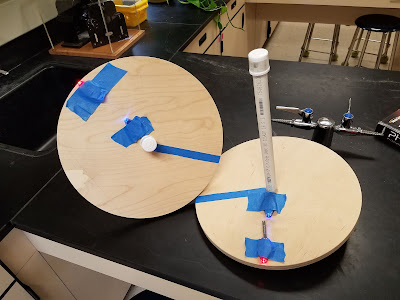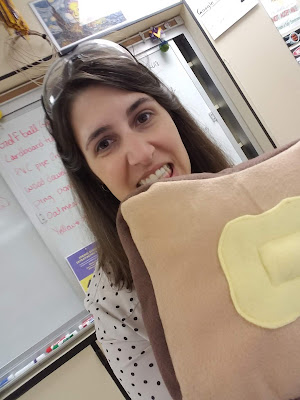In my AP Physics C class we finished our rotation and angular quantities unit before the break. Somehow that means I had a lot of props out. My front counter and support table were filled with spinning things, mostly on the large side because I have 35 kids in one class and they aren't close to the front. Many I've made or assembled myself, and since they were fairly simple to do I thought I would share.
I put one of my bike wheels on a tall ring stand so that I could put it on a lab bench and make it tall enough for everyone to see. Mounting one securely to the ring stand was tricky and only one of my four loose bike wheels did so securely. Unfortunately that was the heavy wheel meant for demonstrating angular momentum so it stops quickly. In the future I'm sure I can rig something up for one of my lighter wheels that would rotate for longer when I have more time.
I wanted students to get a better sense of the angle it was moving through and wanted to mark a radial line on the wheel. At first I thought of a strip of masking or painter's tape but I ended up with a neon straw. I had a jumbo neon straw pack and split them up the length so I could put it on the spoke. It ends up being pretty easy to see so I like the effect. I did the same to a loose bike wheel I was holding and spinning during the lecture.
 In a previous post I shared how I made these wood and PVC tops. I got these perfectly circular hunks of wood from RAFT and made model tops for students to use for explanations. They could also hold blinkie lights or accelerometers on them. For our first lecture on rotation I added a radial line in painter's tape and two blinkie lights, one top had them on the bottom for facing students and the other on top for being viewed from above.
In a previous post I shared how I made these wood and PVC tops. I got these perfectly circular hunks of wood from RAFT and made model tops for students to use for explanations. They could also hold blinkie lights or accelerometers on them. For our first lecture on rotation I added a radial line in painter's tape and two blinkie lights, one top had them on the bottom for facing students and the other on top for being viewed from above. One of the problems students have that week involved a piece of buttered toast falling off a table and rotating. I noticed that when I tried to do the problem the first time I was trying to visualize it by rotating my hands the same way and thought, "This would be so much easier with a piece of bread." So I made an enlarged piece of bread, like a pillow, to model this problem with my students. They get a good laugh out of it but more importantly a lot of them that didn't understand before seem to understand.
One of the problems students have that week involved a piece of buttered toast falling off a table and rotating. I noticed that when I tried to do the problem the first time I was trying to visualize it by rotating my hands the same way and thought, "This would be so much easier with a piece of bread." So I made an enlarged piece of bread, like a pillow, to model this problem with my students. They get a good laugh out of it but more importantly a lot of them that didn't understand before seem to understand.Last year I wrote "make giant egg to show non-level translation" on my ever growing "To Do" list. Now the year has come full circle (*ba dum ching*) so I figured I should make it. We recently redid a bathroom and I had a large white oval of 3/4" plywood laying around. I used out bandsaw to cut it roughly into an egg shape and drilled a hole through the center of it. I had another large circle from RAFT that I sanded down and put a hole through its center too. I inserted a dowel into each so that I can hold it from the back and roll it across my front table. For the circle the wheel as it rolls (rotates and translates) the center of the circle remains the same height off the table. When the egg shape rolls the center of the egg raises and lowers relative to the table. If I was able to shove the objects like a wheel and seem them roll by themselves for a while you would see the egg roll at different speeds depending on what portion was in contact with the floor. The whole point of this one is to illustrate our simplification of problems by using spheres or cylinders or disks that have circular cross sections.
I made this inertia demonstrator last year, it kind of looks like a tape dispenser. Students can pass it around and try to rotate it around the three different axis so they can feel the difference in inertia. I use it to describe how we determine inertia for an object and then also to demonstrate the Parallel Axis Theorem.
I saw a gif on Twitter last year showing a Hoberman Sphere used as a conservation angular momentum demonstration. I bought the sphere too late to try it last year but was excited to hook it up this year. There are holes within the plastic joint pieces that you can thread string or in my case fishing line through. You begin with the sphere fully expanded and spinning slowly. As you pull on the string to force it to contract the angular speed increases. I had a colleague help me get this video:
Between all of those and some fifty some odd objects being rolled down boards for our Rotational Derby Lab, it was a very crowded classroom!

1 comment:
You are a production monarch!
Post a Comment